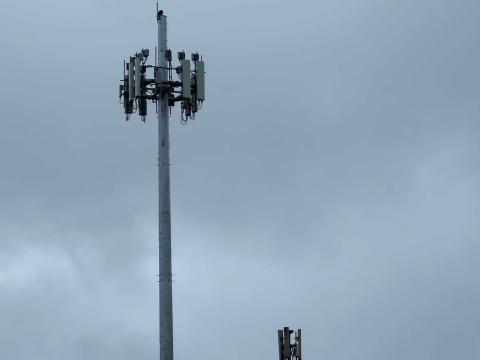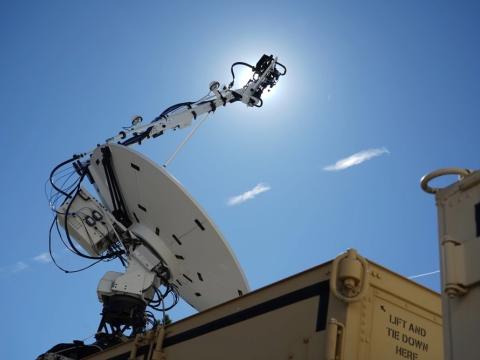Multinational Forces Hit Interoperability Mark
Stage is set for capability surge.
Participants in the Joint Warrior Interoperability Demonstration are reeling from the triumph of this year’s event, not only because all the pieces came together successfully but also because the lessons learned promise to provide real support to today’s warfighters. In addition to focusing on interoperability issues, other substantive items were addressed, including the unique challenges of operating in the Pacific Theater, handling information disclosure problems and ensuring that network vulnerabilities are identified. Broad and successful foreign involvement in the U.S.-sponsored event confirmed that collaboration among nations is essential to defeating today’s adversaries.
In the years since the first Joint Warrior Interoperability Demonstration (JWID) was staged, the event has evolved from resembling a science fair to a highly professional and rigorous test of a handful of technologies being considered for development and acquisition. In JWID 2002, held at 10 sites worldwide in May, the focus was an interoperability surge (SIGNAL, May, page 35). The real value of this year’s event, says Col. Gary R. Bradley, USMC, is not only what took place during the execution but also all of the planning that came before it and the extensive report that will result from the evaluation of the effort. Col. Bradley is the director of the JWID 2002 Joint Project Office, U.S. Marine Corps Systems Command, Hampton, Virginia.
“From my perspective, if it doesn’t support the CINC [commander in chief] with what we did, if it doesn’t support the operational commanders and also if it doesn’t offer value-added to the service acquisition agencies, we’ve failed in our mission,” the colonel says.
He is quick to point out that the achievements of JWID 2002 were a team effort. U.S. Pacific Command (USPACOM), Camp H.M. Smith, Hawaii, hosted the event as the operational CINC and developed the scenario and technology forces to meet operational and warfighter requirements for the event. However, not only did all four services and the Joint Staff contribute greatly to the demonstration, but also organizations such as the National Imagery and Mapping Agency played a significant role. That agency worked with Australian forces to develop up-to-date maps of the area of operations. This work resulted in a fully developed database that will be valuable to today’s forces and is considered a surge capability, Col. Bradley points out.
“In addition, the National Security Agency did a tremendous job in keeping us on the straight and narrow and helping us with the foreign sources disclosure problems. This was not really out-of-the-box thinking. It was just helping us deal with the challenges we face today. We’ve taken a major step forward to handle information disclosure problems,” he indicates.
Although the event still examines specific technologies, Col. Bradley emphasizes that JWID 2002 took a broader approach. “When we look at the problems of the day, we are not looking for a single solution but at forming a template that would be solutions for the warfighter,” he explains. Technologies such as the Global Broadcast System and Australia’s Theater Broadcast System were a great success for sharing information, but other challenges emerged that were in the policy realm, he adds. For example, one week prior to the event, the U.S. Air Force notified the project office that their policy would not allow them to share global positioning system information. It took a collaborative effort to finally resolve the problem.
Another effective multinational collaborative effort ensured that the network was secure. A team of specialists from New Zealand, the United Kingdom, Spain, and Australia and led by the United States constantly evaluated the systems. They monitored all of the circuits, computer networks and data to test the vulnerability throughout the networks. Col. Bradley shares that the team discovered an intrusion into the JWID network and, although apparently not a malicious breach, was able to isolate and stop it.
One piece of the JWID final report will be the security assessment of each system, which will describe an architectural template of each system. It will identify the points and types of vulnerabilities and will act as a standard for assessment and analysis as well as examine the requirements to develop and enhance future assessments, the colonel says.
Lt. Cmdr. Michael G. Ward, USN, operations officer, JWID Joint Project Office, points out that the 2002 event was the first JWID to involve all nine U.S. combatant commands as well as to designate another country—Australia—as one of the scenario’s component commanders. One of the huge problems that had to be resolved as a result of Australia’s role, the commander says, was how to marry the Australian Joint Command and Control System (JCCS) with the U.S. Global Command and Control System (GCCS). The final solution involved placing the JCCS in the middle of the GCCS architecture, which allowed information about the common operational picture to be sent up and down the chain of command.
The event also demonstrated a number of firsts in the fire support systems arena. One trial successfully coupled the U.S. Army’s Advanced Field Artillery Tactical Data System with its Australian counterpart. In addition, JWID participants worked extensively on the air tasking order (ATO) process using extensible markup language (XML) and coordinating with the Canadians’ wing and squadron planning system and the dynamic scheduling system. Multinational collaboration in the ATO field is challenging, Cmdr. Ward points out, because data fields in systems from different countries do not always match. Using XML, U.S. forces were able to take information from the Canadian system and incorporate it into their ATO.
Col. Bradley notes that data sharing in real time in the ATO has been a continuing problem. This capability is critical because it allows coalition members to respond in a timely manner. The improvements are not just a technical achievement but also an operational advantage, he says.
Cmdr. Ward relates that for the first time a number of virtual operations took place at JWID. In this context, virtual refers to products and systems that were sent to the demonstration without a full support team. Although this added information and capabilities to the event, the commander points out that the real lesson learned was that operators need to be trained adequately to reap the full benefits of a technology. “That was a good lesson to learn especially when there are new technologies coming out and you don’t know the education level of the user,” he says.
Col. Bradley adds that the human element is critical to the assessment process. Only personnel who are familiar with a technology can adequately assess its pros and cons. This year’s event matched up the right people with the right systems, which is a significant benefit, he adds.
The defense collaborative tool suite (DCTS) also was well received. Cmdr. Ward reveals that the system was set up to allow instant messaging that featured language translation. Initial languages included Italian, French and Spanish, then Japanese, Thai and Korean were added. Representatives from Japan, Thailand and Korea were pleased that JWID organizers took the time to add their languages, particularly because they only were observing and not participating in the event.
Capt. Chet J. Malins, USN, USPACOM, led JWID and says he was impressed by the way the coalition task force commanders pulled together to form a cohesive operational cell and then were able to use the tools and the scenario. “Any time you have an operation of this complexity, there are a lot of challenges to get all the moving parts to gel. When introducing the Pacific coalition partners, we recognized early in the planning process that there would be some angst during the process. But then we also recognized that it was important, and everyone pulled together,” Capt. Malins relates.
JWID 2002 featured robust operational maneuvers without going beyond the parameters of a demonstration and into the realm of an exercise. Going into the JWID planning process, USPACOM was interested in a realistic scenario, and the captain says he is satisfied that the event reflected the challenges in the world today. Some of the items that were examined are already on a vector to be introduced to the services; however, the newer technologies will have to be evaluated before they can be inserted, he adds.
Capt. Christopher G. Fennig, USN, who was the combined task force commander for JWID 2002, relates that he was very impressed with the preparations, technical processes and procedures at the event, particularly because the participants were separated in space and time. Past JWIDs identified interoperability among nations in terms of standards and tools for security, network management and information management. While the first two have been addressed in the past, information management “was always the harder nut to crack,” Capt. Fennig says. However, this year, USPACOM focused on information management that was independent of distance, and various technologies, including Internet protocol for voice communications, DCTS, e-mail as well as Web and collaborative tools gave this year’s component commanders a greater range of information, he maintains. Although improvement is still needed for how information is shared, the Pacific Theater virtual private network strategy was excellent, he adds.
“So, the level of interoperability between nations has seriously advanced. If it hasn’t already, it should be used in a real world operation soon,” Capt. Fennig notes.
Capt. Charles Edwards, USN, JWID’s maritime component commander, explains that one of his group’s tasks was to test some of the technologies used to hit specific targets. Personnel used handheld computers to view the types of fire in an area and communicate the coordinates of a target. They were impressed by the system, he relates.
Capt. Edwards particularly liked the capability to access maps provided by different organizations from a single screen. The ability to share files and work collaboratively using different venues through the DCTS offers an alternative means for communication in case one system goes down. This backup capability is important, he adds.
Lt. Col. A. Jackson Harris, USAF, JWID’s air component commander, relates that the New Zealand, Canadian and Australian forces at Hurlburt Field, Florida, contributed greatly to the interaction on the issue of business processes. Although certain actions were transparent to the U.S. forces, at times the international contingent did not understand how a technology was going to be used. Having representatives from other countries on site facilitated communications, so direct feedback was possible, Col. Harris offers.
The colonel explains that much of the activity at Hurlburt was scripted, and he would like to see future demonstrations include a more fluid environment. This modification would require more planning; however, some actions could be done on the fly, and this would stress the systems, which would provide additional insight about them, he points out.
JWID 2002 was truly an international effort with numerous countries participating and running their own demonstrations and others acting as observers. Capt. Malins relates that all the nations contributed greatly to the effort, and Australia in particular went above and beyond the call of duty in providing a level of support throughout the planning process, scenario development and execution of the event. Nations new to JWID learned valuable lessons and found out how they can leverage their technologies, he adds.
Capt. Malins and Col. Bradley agree that key to the success of JWID 2002 was network reliability, which was at 100 percent, and system reliability, which topped 98 percent. “All of us took for granted the stability and connectivity, so we want to see further enhancements in the scenario. We want more aggressive challenges, and we got to that point because so much of the technical infrastructure was in place and reliable,” Capt. Malins states.
Beginning next year, JWID will no longer be led by an individual service. Instead, the Defense Information Systems Agency will lead the event. In addition, the traditional two-year cycle will change. JWID will be held every year.




Comments